Advertisement
Got an unusual anchoring situation where basic methods aren’t enough? Here are some advanced techniques to try.
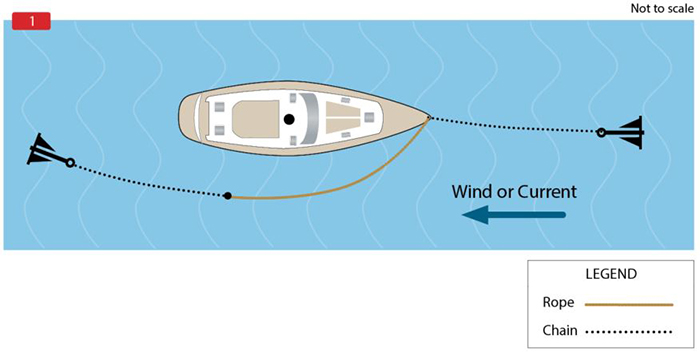
With a Bahamian moor, when the current reverses, the bow turns, and the up-current anchor takes the load. Anchors can be of any type suitable for the bottom and circumstances.
All boaters eventually encounter unique situations where the basic anchoring techniques they’ve employed countless times before just aren’t cutting it. An anchor that won’t stop dragging (no matter how many times you reset it), or anchoring in shifting current and winds, are problems that can be addressed when you know the proper techniques and when to use them. Here’s a look at some examples of how to up your anchoring game when the need arises.
1. Dealing With Current Change
Want to drop the hook in area that experiences 180-degree current shifts but worry your typical single-anchor setup may break free during current shifts? The Bahamian moor was developed to deal with this very situation. It consists of one anchor deployed upstream and a second downstream, allowing your boat to ride between the two with both anchor rodes attached at the bow. As the boat swings 180 degrees during current shifts, the first and second anchors alternate between riding anchor (the one upstream under tension) and lee anchor (the one down current with no load) with your boat always pointing “bow up,” or into the current. The Bahamian moor provides a secure way to anchor in areas with reversing currents and can also be used to limit a vessel’s swing radius in other situations.
Downsides to the Bahamian moor include the possibility of twisted rodes (a result of vessel 360-degree swings, or circles during current shifts), chafe of combination (rope-and- chain) rodes when used with a second all-chain rode, or the slack rode rubbing against the hull or snagging the keel or running gear (possibly preventing the vessel from swinging to its new position with each current change). The latter can be prevented by bridling or attaching the rodes together at deck level, then lowering them until they reach below the keel or running gear. If one of the rodes is all-chain, the chain’s weight is normally enough to accomplish this, but you may need a kellet – a weight attached to the rode – if you use two combination rodes. Another downside can be lack of a quick retrieval should you or someone upwind of you break loose, but often that can be handled by casting off one line (usually the lee line and anchor), taking care to keep the prop free, and coming back to get it later.
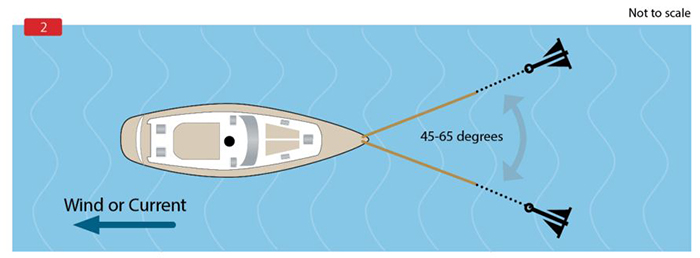
When dual anchor mooring, use two similar anchors with similar rode, if possible. Use adequate scope.
2. Wind Shifts
If the problem is shifting winds, try dual-anchor mooring. Set two anchors to windward 45 to 60 degrees apart, so the rodes form a V with the boat centered in its apex. The simplest way to accomplish this in light winds is to lower the first anchor, motor at a right angle across the wind the intended length of the first anchor rode and then release the second anchor, adjusting the rodes as needed afterward while falling back between the two. In strong winds, set the first anchor as you would normally (with the length of rode you need) then motor upwind at a 45-degree angle. Drop the second anchor when abreast of the first, then fall back between the two, again adjusting the rodes as necessary.
Be sure to monitor rode locations during both procedures (especially combination rodes) to avoid sucking them into your prop.
Deploying matching rodes (either combination or all chain) for both anchors makes it easier to correctly position the boat. You can mix rode types if necessary – just be sure to increase the scope of the combination rode to match the holding power of an all-chain rode.
An added benefit of the dual-anchor mooring is the option of paying out additional rode as the wind pipes up. Increasing the length of your anchor rode reduces the angle between the two anchors, which in turn increases their holding power (35 degrees is considered optimal in gale conditions). Placing your largest anchor in the direction of the strongest expected winds will also improve holding power.
Anchoring For Success
The most important way to successfully anchor is to prepare. From scoping out a potential storm anchorage months before you need it to making sure that the mooring swivel you plan on using is actually is large enough to accommodate three anchor rode shackles, the time to plan is now, not when you need to use that Bahamian moor, or when heavy weather is bearing down. Practice deploying your anchoring system beforehand. This not only allows you to catch and correct issues you may have missed (such as deck chocks too small for double rodes, or larger storm rodes with chafe gear) but also familiarizes you with deploying your anchoring system, making it easier during the real thing.
Learn more at BoatUs.com/Anchoring.
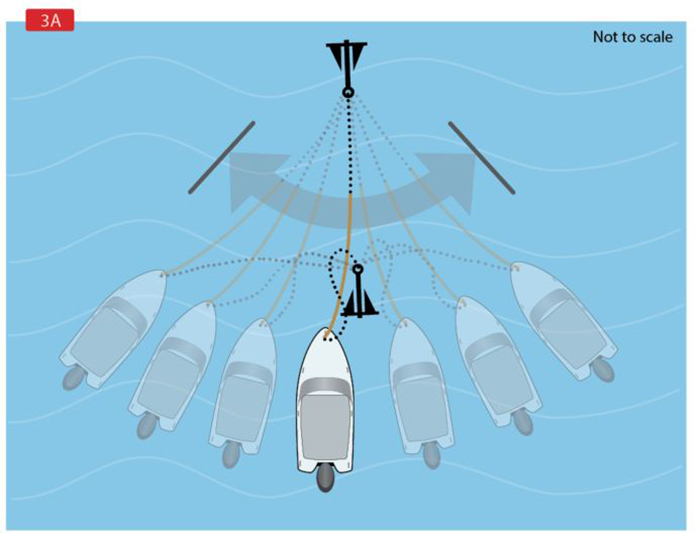
A hammerlock moor uses the practice of “drudging” to reduce vessel movement in gusty winds. The short rode is shown here in transition.
3. Heavy Weather
The hammerlock moor (illustration 3A) is hard to beat if your boat is horsing about in gusty winds. It consists of dropping a secondary anchor on short scope beneath the boat’s bow. The primary anchor continues to take the brunt of the anchoring load, but the boat’s horsing will be dampened by the secondary, which also reduces ground tackle strain considerably. During substantial wind changes, this secondary anchor will likely drag to a new position relative to the wind shift. Relax. It’s all part of the master plan of drudging – the intentional dragging of an anchor. Once settled in the new position, it’ll continue to operate as before.
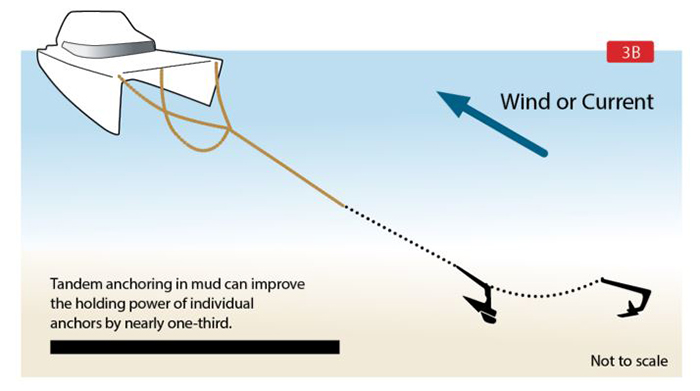
A tandem-anchor rig (illustration 3B) is a quick, easy way for those using a single anchor rode to increase holding power, specifically in mud. Non-pivoting anchors (such as the CQR or Delta) work best in this application. Be sure to attach the second or aft anchor to the shank of the forward anchor – never to the trip eye, which may cause the anchor to roll and unset during wind shifts. Navy tests show that using tandem anchors in mud increases total holding power by as much as 30% over the same two anchors if deployed separately.
Holding power in sand increased only slightly overall, most likely because the anchors themselves were designed for use in sand; in other words, a tandem rig simply closes the holding gap a bit between sand and the poorer holding quality of mud.
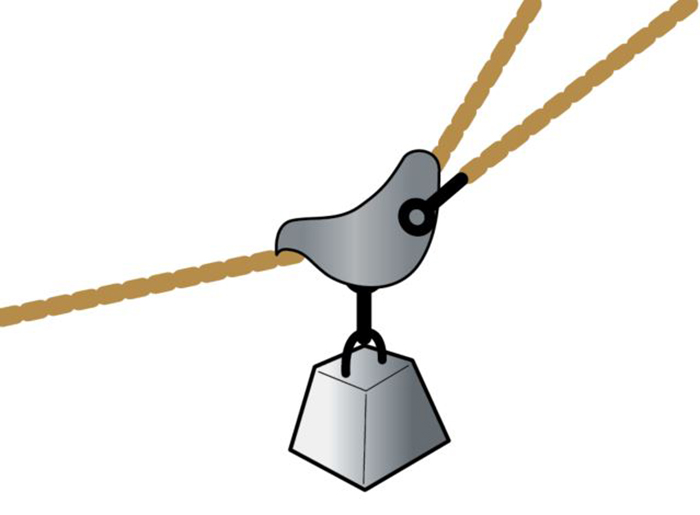
Kellets: A Secret Weapon
There are additional tricks to improve your boat’s performance while anchored that have nothing to do with the anchor itself. One is using a kellet (also known as an “angel” or “sentinel”), which is simply a weight sent down the rode once the anchor is set, to steepen its entry angle and decrease the anchor’s lead angle on the bottom. A kellet can be useful in many situations, such as when dragging anchor in an anchorage that’s too crowded to make paying out additional rode a viable option. — F.L.
